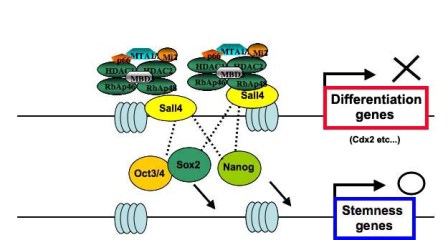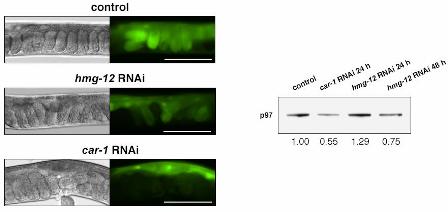
Sall4 is essential for stabilization, but not pluripotency, of embryonic stem cells by repressing aberrant trophectoderm gene expression Shunsuke Yuri, Sayoko Fujimura, Keisuke Nimura, Naoki Takeda, Yayoi Toyooka, Yu-ichi Fujimura Hiroyuki Aburatani, Kiyoe Ura, Haruhiko Koseki, Hitoshi Niwa, and Ryuichi Nishinakamura. Stem Cells (2009) 27(4):796-805 .
Sall4 is a mouse homolog of a causative gene of the autosomal dominant disorder Okihiro syndrome. We previously showed that Sall4 absence leads to lethality during peri-implantation and that Sall4 -null embryonic stem (ES) cells proliferate poorly with intact pluripotency when cultured on feeder cells. Here, we report that, in the absence of feeder cells, Sall4 -null ES cells express the trophectoderm marker Cdx2 , but are maintained for a long period in an undifferentiated state with minimally affected Oct3/4 expression. Feeder-free Sall4 -null ES cells contribute solely to the inner cell mass and epiblast in vivo , indicating that these cells still retain pluripotency and do not fully commit to the trophectoderm. These phenotypes could arise from de-repression of the Cdx2 promoter, which is normally suppressed by Sall4 and the Mi2/NuRD HDAC complex. However, proliferation was impaired and G1 phase prolonged in the absence of Sall4 , suggesting another role for Sall4 in cell cycle control. Although Sall1 , also a Sall family gene, is known to genetically interact with Sall4 in vivo , Sall1 -null ES cells have no apparent defects and no exacerbation is observed in ES cells lacking both Sall1 and Sall4 , compared with Sall4 -null cells. This suggests a unique role for Sall4 in ES cells. Thus, though Sall4 does not contribute to the central machinery of the pluripotency, it stabilizes ES cells by repressing aberrant trophectoderm gene expression.


Figure: Sall4 binds to the Mi2/NuRD complex and represses Cdx2 expression.